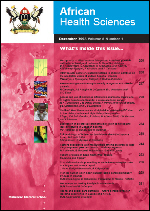
|
African Health Sciences
Makerere University Medical School
ISSN: 1680-6905
EISSN: 1680-6905
Vol. 14, No. 3, 2014, pp. 682-688
|
 Bioline Code: hs14102
Bioline Code: hs14102
Full paper language: English
Document type: Research Article
Document available free of charge
|
|
|
African Health Sciences, Vol. 14, No. 3, 2014, pp. 682-688
| en |
Prevalence and outcomes of acute kidney injury in term neonates with perinatal asphyxia
Alaro, Dan; Bashir, Admani; Musoke, Rachel & Wanaiana, Lucy
Abstract
Background: The kidney is the most damaged organ in asphyxiated full-term infants. The severity of its damage is correlated with the severity of neurological damage. We determined the prevalence of perinatal asphyxia-associated acute kidney injury (AKI).
Methods: We conducted a prospective cohort study including 60 full-term neonates admitted at the Kenyatta National Hospital newborn unit (NBU) in Nairobi with hypoxic ischaemic encephalopathy (HIE) from June 2012 to November 2012. Renal function was assessed by measuring serum creatinine on day 3 of life. AKI was defined by a level of creatinine above 133 μmol/l. The degree of neurological impairment was determined daily until patient discharge, death or day 7 of life.
Results: Of the 60 infants 36.6% had HIE I, 51.6% HIE II and 11.8% HIE III. The prevalence of AKI was 11.7 %. There was a 15 fold increase risk of developing AKI in HIE III versus HIE I, p=0.034. Mortality rate in perinatal asphyxia associated AKI was 71.4 % with a 24 fold increase risk of death in neonates with AKI, p=0.001.
Conclusions: AKI is common and associated with poorer outcomes in perinatal asphyxia. Larger studies need to be done to correlate maternal factors and perinatal asphyxia-associated AKI.
Keywords
moderate perinatal asphyxia; evere perinatal asphyxia; hypoxic ischaemic encephalopathys; neonatal kidney dysfunction; neonatal neurological dysfunction
|
| |
© Copyright 2014 - African Health Sciences
|
|
